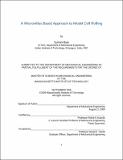A microvillus based approach to model cell rolling
Author(s)
Bose, Suman
DownloadFull printable version (550.3Kb)
Other Contributors
Massachusetts Institute of Technology. Dept. of Mechanical Engineering.
Advisor
Rohit N. Karnik.
Terms of use
Metadata
Show full item recordAbstract
Cell rolling is a physiological phenomenon, which allows leukocytes to attach to activated vascular endothelium and reach sites of inflammation. A novel approach to model cell rolling is presented in this thesis. The model incorporates all the aspects known to be important to rolling in a semi-analytical framework making it computationally efficient. Bond kinetics have been used to define microvillus attachment probability which is in turn used to find out the net force on the cell. Deformability is also taken into account by an empirical relation which allows shear modulation of cell-surface contact area. The model showed excellent agreement with experimental results over a wide range of shear stresses. Using the model, the effects of cell deformability and microvillus structure have been studied and its implications discussed. The model was also used to predict rolling of microspheres, which showed reasonable agreement with experiments. Finally, the contribution of different features towards stabilization of rolling was elucidated by simulating different hypothetical cases with contributions from different cellular features.
Description
Thesis (S.M.)--Massachusetts Institute of Technology, Dept. of Mechanical Engineering, 2009. This electronic version was submitted by the student author. The certified thesis is available in the Institute Archives and Special Collections. Cataloged from student submitted PDF version of thesis. Includes bibliographical references (p. 45-50).
Date issued
2009Department
Massachusetts Institute of Technology. Department of Mechanical EngineeringPublisher
Massachusetts Institute of Technology
Keywords
Mechanical Engineering.